What is employee recognition?
Employee recognition, or appreciation, is all about acknowledging the hard work and accomplishments of the individuals and teams within your organization.
And since 2020, with the unprecedented, rapid workplace changes of the pandemic, the nature of employee recognition has changed. What was once the ‘nice to have’ benefit of employee recognition is now essential. Today, employee recognition programs help boost morale, motivate employees, and keep remote teams connected and productive.
Employee recognition takes two forms:
- Top down recognition: this comes from managers, supervisors or other business leaders
- Peer to peer recognition: an expression of appreciation and commendation among co-workers.
Free eBook: Designing an EX program that attracts and retains talent
Employee recognition and company culture
Core company values are where a successful employee recognition program should begin, and it’s company culture where employees feel valued that sets the standard.
As an example of what not to do: a company package may offer generous Paid Time Off (PTO) yet the culture could be one of overwork where taking time off is frowned upon.
Employee recognition is closely linked with a positive company culture. Survey analysis by Great Place to Work compared employees who received recognition to those who didn’t. They found that when employees feel valued and are recognized at work, they are:
- 6 times more likely to believe that promotions are fair
- 2 times more likely to say that the innovative thinking gets embraced
- 0 times more likely to say ‘people here are willing to go above and beyond’
The study also found that “Recognize me” is the most important driver of great work:
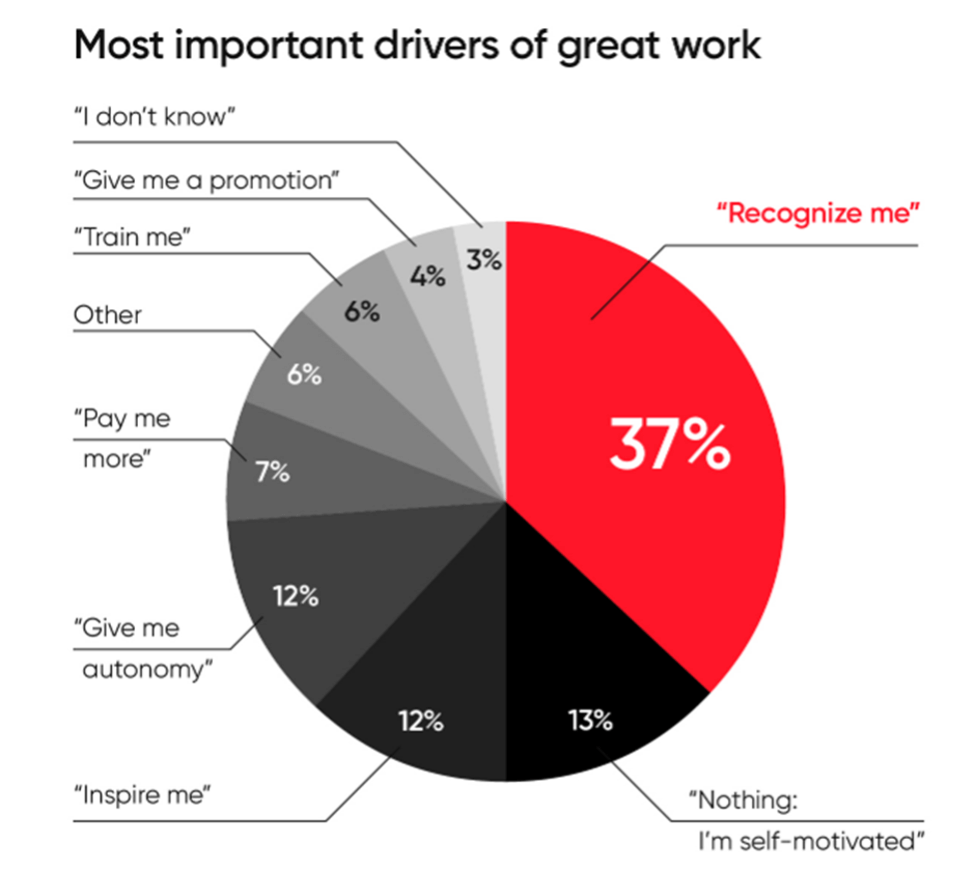
To recognize employees appropriately, you may need to look at your company culture and make sure it chimes with company values — a culture of recognition, if you like. If not, realign it!
What are the benefits of employee recognition?
Organizations with a solid employee recognition strategy can expect higher employee engagement, better employee morale, improved customer service and lower employee turnover.
Companies that recognize and reward employees well can even expect 50% higher productivity and as much as a 20% increase in business outcomes.
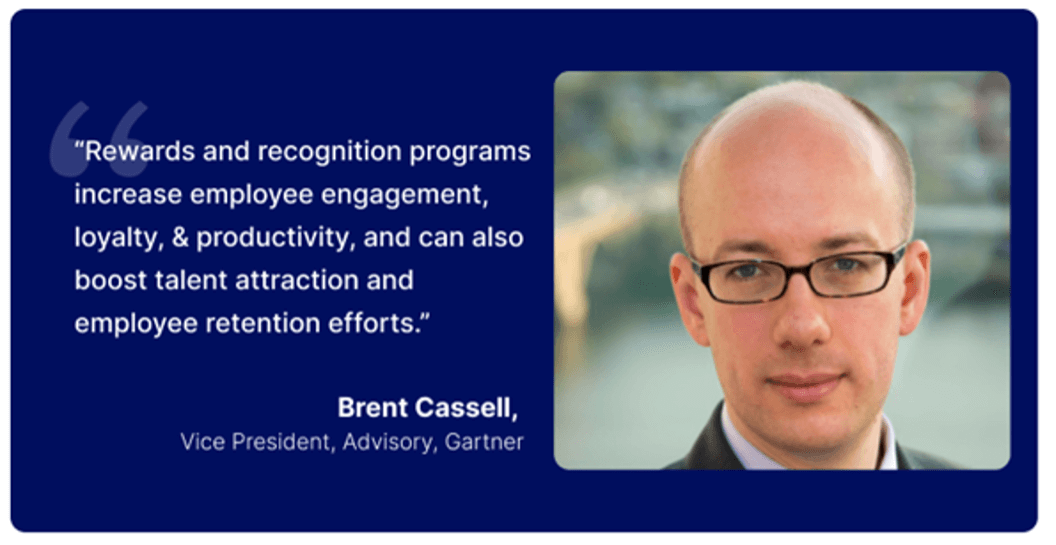
Improve employee engagement
Research has shown that manager recognition plays an important role in maintaining high levels of employee engagement. Often, employees who don’t feel recognized become less engaged over time and are more likely to leave.
Employees who are highly satisfied with the amount of recognition they receive from their managers tend to stay at consistently high levels of engagement over time. They are also less likely to transfer out of their team or leave the organization completely.
Employee wellbeing
According to Psychology Today, key areas of the brain, such as the hypothalamus, and the ‘reward neurotransmitter’ dopamine, are stimulated by positive feelings from gratitude. Receiving timely recognition can increase wellbeing, metabolism, aid better sleep and reduce stress. When employees feel appreciated, they feel well, and they perform better at work.
Employee recognition is one of the five key components of a healthy workplace according to the American Psychological Association, along with:
- work-life balance
- health and safety
- employee growth and development
- employee involvement
Employee retention
A U.S. Bureau of Labor and Statistics study asked transfers why they changed jobs. The vast majority of respondents indicated they had felt either a lack of respect or a lack of autonomy. A bit of recognition can go a long way to prevent or even reverse those feelings in your high performers.
Recognizing employees for good work can help keep high performers motivated, engaged in the company vision, and wanting to stay and contribute. This is crucial because, not only is top talent hard to come by, it’s also expensive to recruit.
Onboarding a new hire could cost as much as $16,999 in recruitment costs.
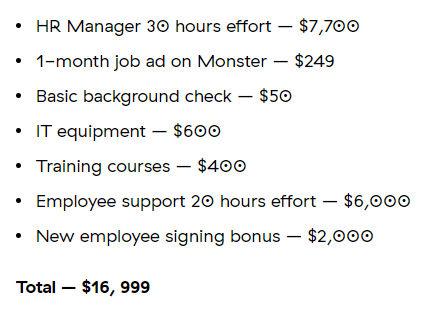
According to Glassdoor, the average US company spends about $4,000 to hire a new employee, taking up to 52 days to fill a position, which translates into lost productivity.
Increased productivity
There’s nothing quite as motivating as feeling mastery over a task, and having it recognized by others. Knowing we’re doing good work that is valued and appreciated by others naturally makes us want to contribute more.
According to research conducted by Globoforce, 79% of employees say recognition makes them work harder and 78% say recognition makes them more productive.
In a laboratory study by economists at the University of Warwick, they found that happiness led to a 12% spike in productivity, while unhappy “workers” were 10% less productive.
While we know that laboratory conditions do not exactly mimic the dynamics of a modern workplace, it is a good indication that there may be a relationship between happiness and productivity that organizations should be aware of.
We find that human happiness has positive effects on productivity. Positive emotions appear to invigorate human beings.
Employee happiness
People want to feel like they’re contributing to their organization and team goals. So when managers and leaders take the time to demonstrate how much of a measurable impact someone is having on the business it, unsurprisingly, makes people feel good about what they do. Feeling good about what you do is crucial and can translate to general feelings of happiness, both in and outside of work.
The act of appreciating others naturally connects people more closely, making individuals feel like valued members of the team.
- 70% of employees say recognition makes them feel emotionally connected to peers
- 70% say recognition makes them happier at home
Enhanced trust
When recognized in the last month, 86% of employees said they trust one another, another 86% said they trust the boss, and 82% said they trust senior leaders. In contrast, only 48% of employees who were not recognized in the past month reported trusting their senior leaders.
Not only is trust key in running a successful business, trust in leadership can also make uncertain times less challenging. When recognized in the last month, 69% of employees said they were excited or confident about an upcoming change, vs. only 41% of those who had never been recognized reporting the same.
In-the-moment feedback
In-the-moment feedback helps foster a culture of appreciation. It should be given by the immediate manager or coworkers familiar with an individual’s work.
Examples could include:
- Saying thank you for a job well done
- Sending a personal note
Informal employee recognition
Informal employee recognition is used to maintain motivation through big tasks or long projects. It is ad hoc and typically provided by a team or project lead. This type of recognition should be commensurate with the milestone achieved.
Examples could include:
- Copying an employee on a complimentary email sent to their boss
- Team lunch
Formal recognition program
Formal employee recognition is a program that has consistent and clearly communicated criteria that aligns with specific company goals or values. It is usually public recognition by a senior leader and used for recognizing employees and achievements that have broad organizational impact and business outcomes.
A great example includes Amazon’s annual Just do it award, which is used to publicly recognize employees who go above and beyond to innovate on behalf of customers. Recipients are presented with the coveted Nike sneaker trophy, which serves as a source of continuing pride for the awardee and motivation for colleagues.
What’s the best way to show employees your appreciation?
Employee recognition is not just about checking the box to say you did it. People can usually recognize when the sentiment isn’t genuine.
Recognition efforts need to be thoughtful and create an emotional connection between employees and the organization.
Reinforcing and rewarding behaviors that align with your company values, mission, vision, and strategy can help achieve this. For example, we call our core values at Qualtrics TACOS:
- Transparent
- All-in
- Customer obsessed
- One team
- Scrappy
If a manager at Qualtrics wants to acknowledge someone for solving a problem in an entrepreneurial way, they might call them “scrappy.” Or, when a team member does everything they can to help a customer smash their targets, they might hail their customer obsession.
This helps to reinforce the kind of employee behavior and attitudes we want to see in our people. In turn, it makes our people feel like they’re living the values of the company.
Make your people feel valued, respected, and cared for to create an emotional connection.
Be specific with praise
Tell employees what you appreciate about their contribution to the company. Be as specific as possible and explain why their work stands out.
For example, don’t just say, “Good job today.” Instead say, “I see that you stepped in to resolve Customer X’s problem. That showed real initiative and helped us avoid a more serious issue in the future. Thank you for doing that.”
Give praise the right way
In order to be meaningful, recognition has to match an individual’s preferred style. Not everyone wants to be brought on stage to rousing applause. Get to know your people and what motivates them.
Consider whether a more personal thank you is appropriate. Kudos that come directly from a manager or team leader tend to be very well-received. It is important to have individuals who are close to an employee’s work recognize their efforts.
Free eBook: Designing an EX program that attracts and retains talent
Employee recognition programs
Here are some great employee recognition ideas for rewarding employee accomplishments.
Years of service
This employee recognition program celebrates the long service record of an employee who has been with the company for maybe 5, 10 or 20 years. What it isn’t, though, is a recognition platform for just turning up at work every day. It needs to be a celebration of the employee’s achievements, learning, experience, work colleagues, and entire team successes.
Customer service award
When an employee or team has gone the extra mile for customers, received outstanding customer feedback or has simply been a great customer service representative overall, they deserve a reward.
Also, when you feel that your company has made a significant contribution to customer experiences, you can even enter national awards such as The US Customer Experience Awards.
Employee appreciation events
Make your employees feel cherished by organizing tangible rewards: appreciation at regular town hall meetings, events or days out to celebrate their achievements. Some ideas include:
- Experiences such as escape rooms, theme park trips, cookery lessons with a celebrity chef, dining out at a high-end restaurant
- Pampering: spa days, manicures, pedicures, massages, mindfulness coaching
- Charity donations to individuals’ or teams’ favorite charities
- Office fun: pizza lunches, an afternoon of games, a photo booth, comedy or talent shows, bring your pet to work
- Volunteer pass: A day off to volunteer at a favorite community project
- Shoutouts: at events to mark milestones such as product launches, hitting sales targets, winning major clients
Monetary awards
When employees perform exceptionally well at work, such as going the extra mile for the team or customers, you may want to offer a financial reward. But bear in mind, stone cold cash from senior management has little emotional meaning unless it is personalized and part of a celebration of a specific achievement.
Monetary appreciation programs can include:
- Bonuses
- Company shares
- Cash awards
- Retailer gift cards
Employee of the Month or Year
It is as it sounds; a regular prize given out to team members who have made a positive impact at work. Done well, it can encourage employees, and make them feel recognized.
But if done badly, it can be demotivating for those who don’t win and make your employee recognition efforts backfire.
Make sure you don’t:
- Give the award to the same team or person all the time
- Let only managers or executives choose the winners
- Muddle the criteria for award eligibility – it should be clear what winners need to do
- Give the same recognition to everyone – personalize it to the employee achievements
- Make Employee of the Month/Year your only employee recognition program.
Learn more about designing an employee recognition program
Great employee recognition programs from three brands we love
Bain & Company
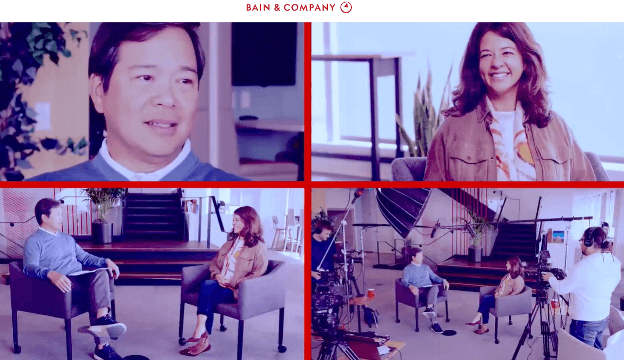
A global management consultancy firm with the motto, ‘A Bainie never lets another Bainie fail,’ Bain & Company is in the Top 3 Glassdoor’s Best Places to Work in 2022.
Bain & Company’s recognition awards are of the positive reinforcement type, and include:
- A generous performance bonus
- Paid days off for a great job done
- Flexibility for employees to work “wherever they feel most productive”
Airbnb
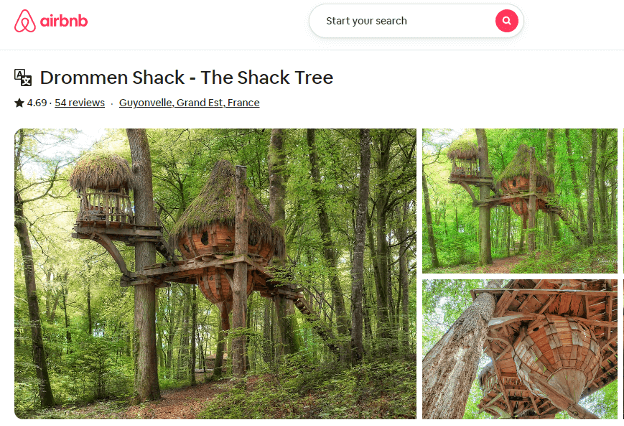
The global holiday rentals platform has a recognition-rich culture, with a ‘Ground Control’ team to look after Airbnb’s ‘Airfam’ and ensure that their workplace is a positive experience.
Employee rewards include:
- Frequent recognition of contribution and milestones
- Paid volunteer time
- Healthy food and snacks
- Birthday and work anniversary recognition
- Themed events
- Free annual travel experiences
Zappos
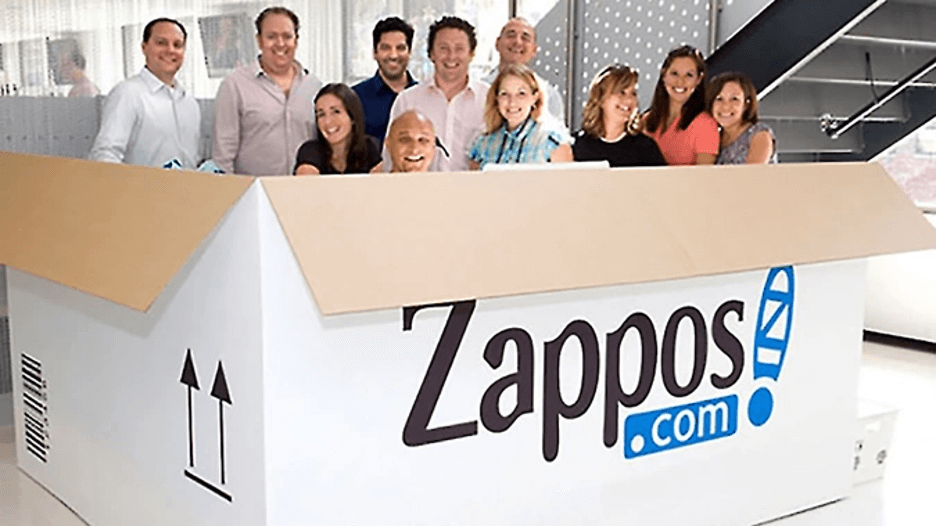
An Amazon subsidiary, Zappos uses peer recognition to build its positive team culture. Zapponians reward each other with the company’s own redeemable currency — Zollars, while filing positive feedback as to why they are giving the award.
Other Zappos peer recognition initiatives include:
- Coworker bonus program – coworkers reward each other with $50 Zollars (managers, supervisors and team leaders are not eligible)
- ‘Master of WOW Parking’: Any Zapponian can award a coveted under-cover parking spot to another employee
- The Zappos HERO Award (Win $150 and a cape!): A Zappos HERO is ‘an employee who embraces our core values to the fullest and lives to deliver WOW to their fellow Zapponians’
Effective employee recognition tools
The most successful employee recognition programs are those that include everyone in the workplace and that are based on good work, rather than solely “employee-of-the-month” type rewards.
As such, when adopting a new recognition tool, employers must communicate the purpose of the tool as well as what metrics will be used to determine rewards. Further, it is important to ensure that employees are aware of the tool and find the rewards meaningful. These considerations are crucial to ensure that your recognition program doesn’t fall flat.
Once you’ve decided on your employee recognition tools, you’ll be able to start designing your employee recognition program.
Collaboration tools
Collaboration tools such as Slack, Google Hangouts, and Microsoft Teams are great for informally thanking your employees. You can even create a specific recognition channel if the intent of the recognition is to give employees more visibility.
Listen to your employees with surveys
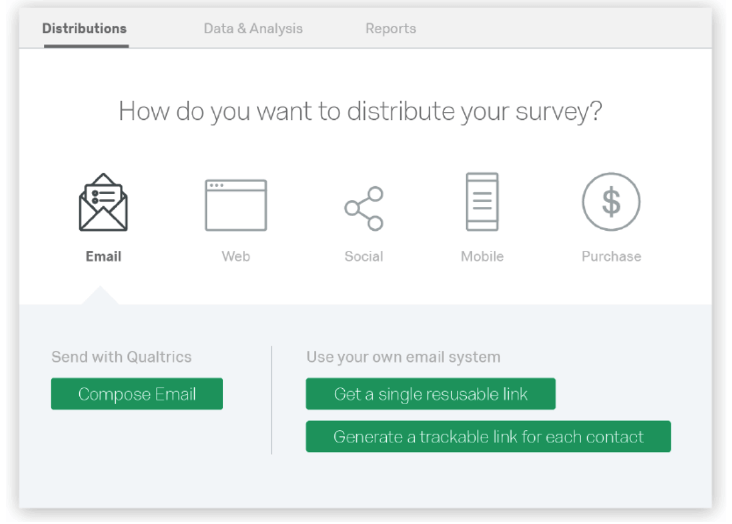
Every successful employee recognition program starts with listening. Listening to your people and hearing what a great job they are doing is the first step to recognizing great employees. Then act on the findings to give great rewards.
The great thing with surveys is you can tailor the questions to discover exactly what you need to know. And with the data you can track employee recognition measurements — and improvements.
Go beyond surveys and create great employee experiences with Qualtrics
When you use Qualtrics, you not only have access to a whole raft of survey types to help improve the employee experience, including:
But more importantly, you have an employee experience platform that can help drive recognition.
Using the Qualtrics Employee Experience platform, everyone from new employees and shop floor workers to managers and the senior vice president can ensure their voice is heard. It’s the ultimate listening tool for gathering continuous feedback from every employee to take the right actions to improve engagement, recognition, talent planning, productivity and innovation.
From the perspective of employee recognition, it empowers managers to implement changes and strategies that keep people front-of-mind and appreciated. They can use AI-powered tools to automatically model the employee experience — e.g., how employees feel about communication, leadership, recognition, satisfaction — and then surface key areas to focus on.
Then, they can use guided action planning tools and automated workflows to go from just measuring the experience to implementing meaningful changes.
Your people are your most important asset. How they feel about your business has a measurable impact. Making sure you recognize and appreciate your employees in the right way not only helps with employee retention, but also with engagement and productivity – and ultimately, your bottom line.
Free eBook: Designing an EX program that attracts and retains talent
Reference List
http://www2.warwick.ac.uk/newsandevents/pressreleases/new_study_shows/
https://blog.shrm.org/blog/how-recognition-makes-workhuman/
https://go.globoforce.com/rs/862-JIQ-698/images/ROIofRecognition.pdf/
http://www.cnbc.com/2017/02/27/why-great-employees-quit.html/
https://bonus.ly/employee-recognition-guide/recognition-tools-techniques-resources/